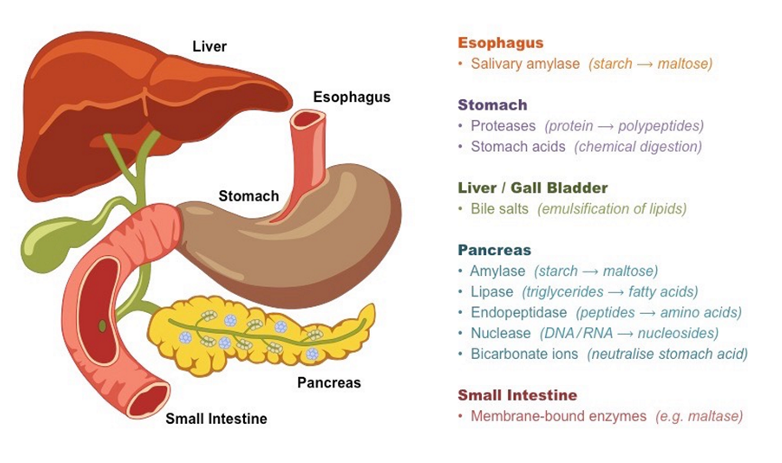Digestive system - Human Biology Yr 11 ATAR
1/96
Earn XP
Description and Tags
Chapter 6
Name | Mastery | Learn | Test | Matching | Spaced |
|---|
No study sessions yet.
97 Terms
Digestive system
. the system that breaks down the food taken into the body to be ready for absorption into cells
. Through: the mechanical + chemical breakdown of food to small molecules that can be absorbed into the body
What 6 activities are the organs of the digestive system arranged to carry out?
ingestion
mechanical digestion
chemical digestion
movement of food
Absorption
elimination
The 7 major food groups
Carbohydrates: contain carbon, hydrogen, and oxygen (bread, potatoes, pasta, rice)
Proteins: contain amino acids (eggs, fish, meat, cheese)
Fats: contain triglycerides (butter, margarine, vegetable oil)
Minerals: inorganic mostly ions (calcium, iron)
Vitamins: organic carbon compounds (B1, B12, D)
Fibre: cereals, corn, wheat
Water: the body is largely composed of water (70%)
Ingestion
. putting food into the digestive system
. the intake of food, liquids or drugs into the mouth
. process of taking food into the digestive system so that it may be hydrolised or digested
Digestion
. the mechanical and chemical breakdown of food to small molecules that can be absorbed into the body (in order to utlise nutrients)
. breaking down the food into nutrients
Absorption
. the movement of nutrients from the intestines into the bloodstream
Elimination (Egestion)
. removal of indigestible material, bacteria and bile pigments from the body
. the removal of undigested food from the digestive system
What are the 2 types of digestion
. mechanical and chemical
Mechanical digestion
. the physical breakdown of large particles of food into smaller particles to increase the SA for digestion
. total SA increases
Mechanical digestion in the mouth
. the teeth bite + crush the food into smaller pieces
—> incisors: front teeth to bite + slice food
—> canines: pointy teeth to bite + tear food
—> premolars: crush the food
—> molars: crush the food
Mechanical digestion in the stomach
3 types of muscle contract to reduce size of food particles:
. longitudinal, circular, diagonal muscle
Mechanical digestion in the small intestine
. bile emulsifies fats
Chemical digestion
. the breakdown of food to small molecules by chemicals
Role of enzymes in chemical digestion
. enzymes break down large insoluble food molecules into smaller, soluble molecules which can be absorbed through small intestine wall to enter the bloodstream
What relationship do the different pH levels of the digestive tract have on enzymes
. different parts of digestive tract have different pH conditions to enable different enzymes to work
identify which enzymes act on carbohydrates, proteins and fats, the source of these enzymes and the products of this enzyme activity
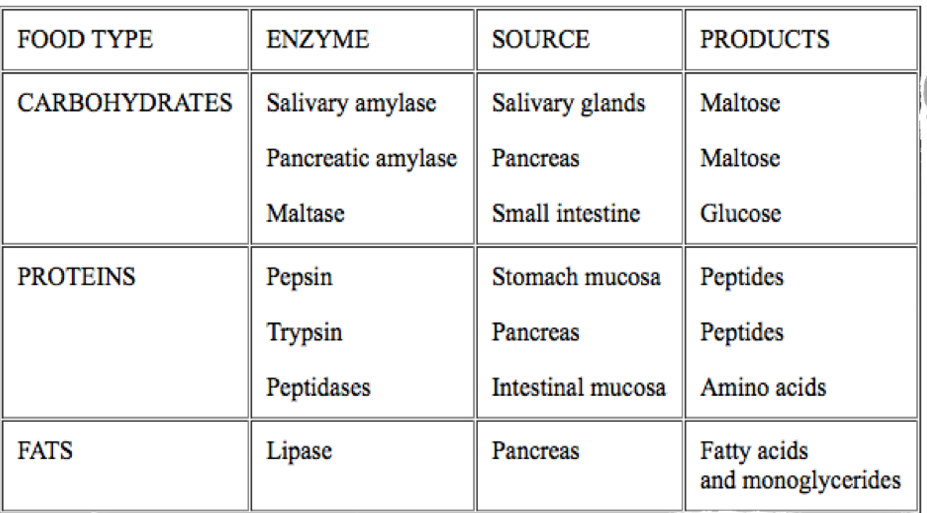
Chemical digestion of carbs, proteins, lipids and nucleic acids
Carbohydrates: split into monosaccharides like glucose + fructose
Proteins: split into peptides + amino acids
Lipids: split into fatty acids + glycerol
Nucleic acids: split into nucleotides (DNA/RNA)
Chemical digestion of carbohydrates
. mouth: food starches are broken down into maltose through the salivary enzyme amylase
. Duodenum: the chyme from stomach mixes with digestive secretion, breaking down the disaccharides into monosaccharides
. 3 enzymes are maltase, sucrase, lactase
. glucose is required for energy through the metabolic pathways
Alimentary canal
. the tube via which food passes through the body
. consists of the mouth cavity, pharynx, oesophagus, stomach, small intestine, large intestine, rectum, anus
. continuous tube that runs from mouth to anus
. the organs that food + liquids travel through when they’re swallowed, digested, absorbed and leave the body as feces
Label the digestive system
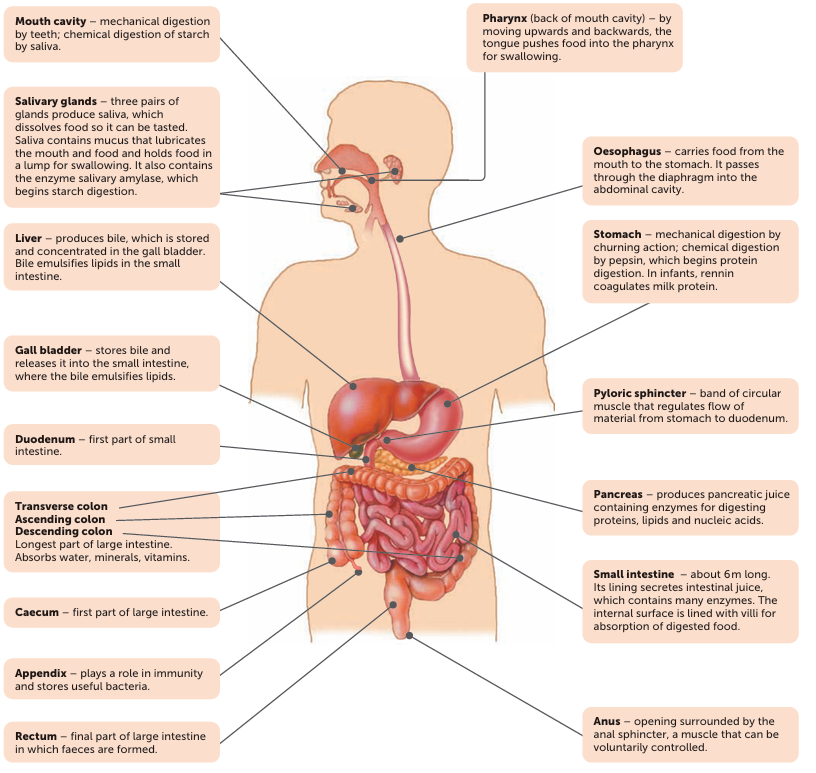
Describe the time spent at each stage of digestion
. after chewing and swallowing, 5-10s for food to pass down oesophagus to stomach, where it spends 2-6 hours being partially digested
. final digestion + nutrient absorption occur in small intestine over 5-6 hours
. in 12-24hrs, any undigested material passes through large intestine + faeces expelled through anus
Describe how food moves from the mouth to the stomach
. in mouth cavity, food chewed into smaller pieces by teeth and mixed with saliva
. tongue rolls food into a soft mass (bolus)
. during swallowing: tongue rises to push bolus towards pharynx
. soft palate moves up → prevents bolus from entering nasal cavity + epiglottis lowers to cover opening to trachea, preventing bolus from entering
. Bolus enters oesophagus → wall of oesophagus consists of circular + longitudinal muscles
—> circular muscles behind contract, longitudinal muscles relax
—> circular muscles in front relax + longitudinal muscles contract
. bolus is pushed down oesophagus via peristalsis to stomach
Bolus
. a ball-like structure of food and saliva
. formed with saliva and the tongue
Peristalsis
. waves of involuntary muscular contraction that push food along the alimentary canal
—> the alternative contraction + relaxation of muscles producing a wave like movement
—> the involuntary reflex action where a wave-like motion propels the content along the digestive tract
How does peristalsis work to move food along the digestive tract?
. as the bolus enters the pharynx + oesophagus, the circular muscle behind it contracts to narrow the tube
—> this movement pushes the food in front of it, assisted by the secretion of mucus that lubricates the inner lining
. muscle in front of bolus relaxes
. muscle behind bolus contracts
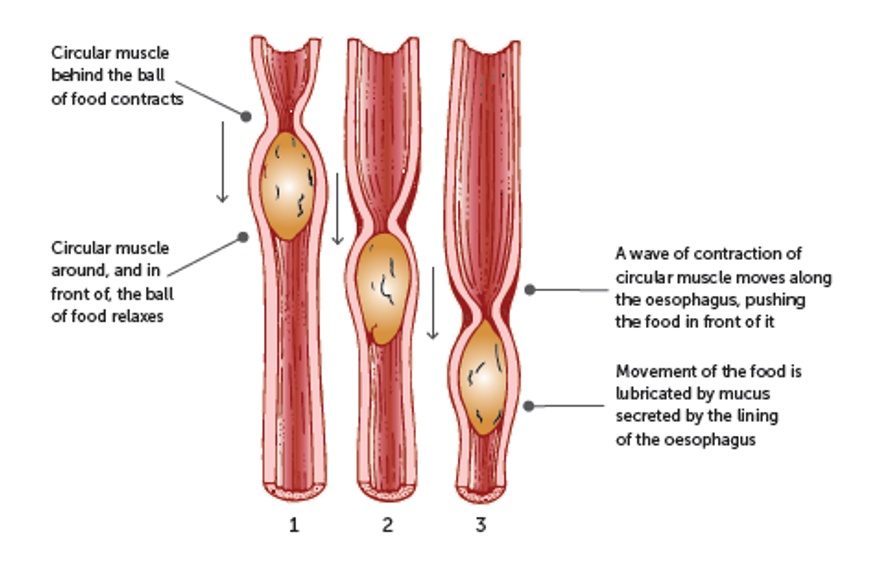
Stomach
. a muscular organ that receives food from the oesophagus, and mixes it with acid and enzymes to form chyme
—> food is temporarily stored
—> gastric juices are secreted (contains enzymes)
—> has 3 layers of muscle that line the inside
Stomach 4 functions
food storage: can stretch to fit 2L food
Disinfect food: HCl = pH 2, kills bacteria
Chemical digestion: pepsin/pepsidase (enzyme breaks down proteins)
Mechanical digestion: muscular contractions (oblique, circular + longitudinal muscles) churns food + mixes it with gastric juice = chyme
What does the stomach do to food
. walls of stomach have 3 muscle layers: circular, longitudinal, oblique/diagonal muscle
—> when food enters stomach, the 3 muscles contract and relax to ensure the food is thoroughly mixed with stomach juices
—> result is a thick, soupy liquid = chyme
. mechanically + chemically breaks down food
Why aren’t nutrients absorbed into the bloodstream through the stomach
. as the internal surface is covered by a thick layer of mucus
—> however substances like alcohol and some drugs may be absorbed through the stomach
What is the lining (mucosa) of the stomach made up of?
. gastric pits + glands which secrete gastric juice
What 3 components does gastric juice contain
. hydrochloric acid (pH 2-3): kills bacteria + disinfects foods
. Mucus: lines the walls of stomach to protect from acid
. Digestive enzymes: pepsin, begins chemical digestion of protein, converting proteins into smaller peptides
How does mechanical digestion occur in the stomach
. muscular contractions (circular + longitudinal muscles) churns food + mixes with gastric juices to form chyme
As the stomach is made out of protein, what stops the stomach from digesting itself?
. mucus secreted by stomach cells protects stomach lining
Describe how food is kept in the stomach and for how long
. lower end of stomach = thickening of circular muscles
—> constriction of pyloric sphincter
—> prevents stomach contents moving through unless pushed by peristalsis
. after 2-8 hours, contents pushed to the next part of alimentary canal (small intestine)
3 main groups of digestive enzymes
Lipase enzymes: digest fatty substrates
Protease enzymes: digest protein substrates (eg pepsin in stomach)
Carbohydrase enzymes: digest carbohydrate substrates (eg amylase in saliva)
The chemical digestion of carbohydrates
. in mouth food starches broken down into maltose through the salivary enzyme amylase
. in duodenum: the chyme from stomach mixes with digestive secretion that break down the disaccharides into monosaccharides
—> enzymes involved are maltase, sucrase, and lactase

Chemical digestion of proteins
. protein → (pepsin enzyme) → large polypeptides → short peptides and amino acids → amino acids
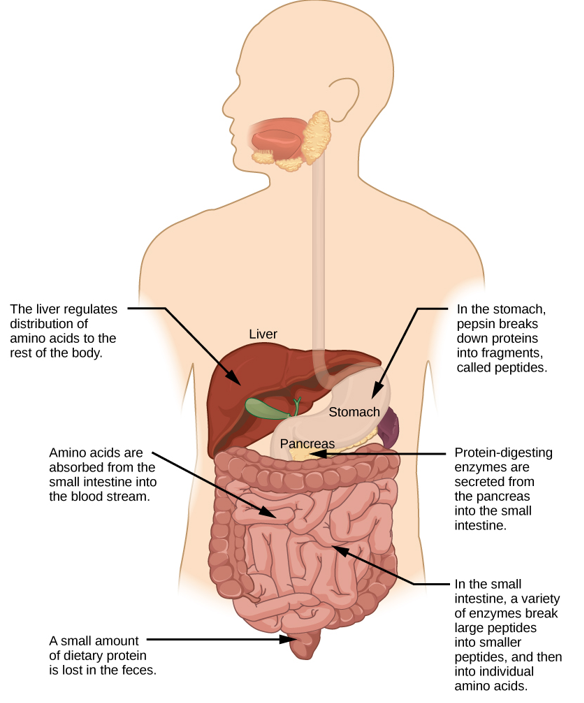
Chemical digestion of lipids
. Lipids (triglyceride) broken down through the lipase enzyme into 2 fatty acids and a monoglyceride
How does chemical digestion occur?
. occurs via enzymes that chemically change food into nutrients
Describe the chemical digestion of carbohydrates, proteins, and lipids in the mouth, stomach and small intestine
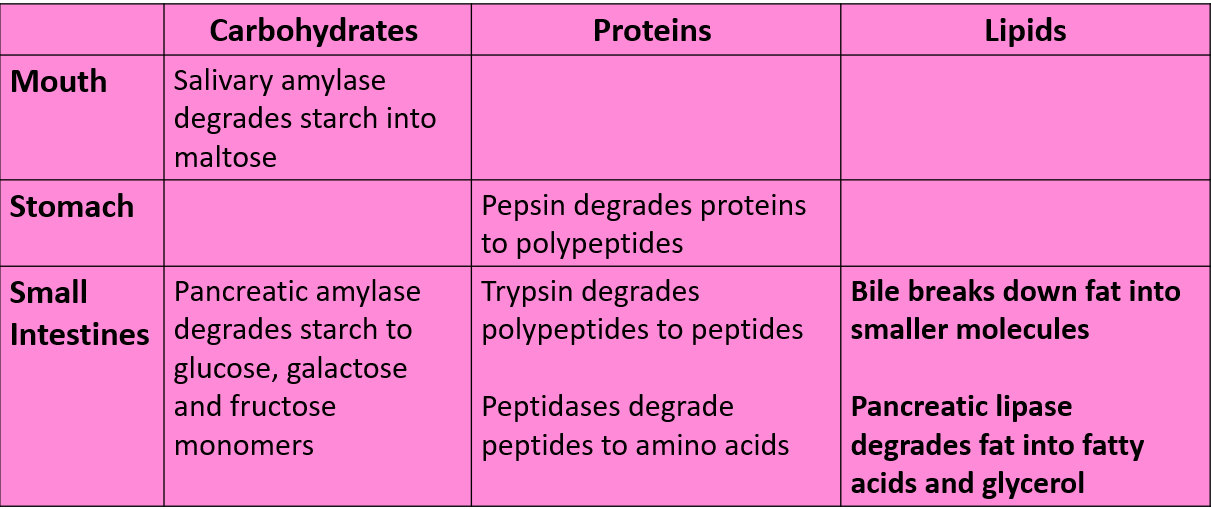
What processes occur in the mouth with food
. Ingestion: intake of food
. mastication: the process of chewing to grind or crush food with the teeth)
. saliva: fluid secreted into mouth by salivary glands to begin digestion of food
. a bolus is formed with saliva and the tongue
—> chemical AND mechanical digestion
—> mechanical: by teeth + tongue to increase SA - food is chewed
—> chemical: saliva (slightly alkaline) moistens the food + releases amylase to break down starch to maltose
What 2 components does the mouth contain to aid digestion
contains mucus to lubricate food
contains salivary amylase to begin starch digestion (starch to maltose)
Role of the teeth in digestion
. with the action of the jaw, the teeth begin mechanical digestion by ripping, tearing and crushing food into smaller particles
. 8 incisors = biting, cutting
. 4 canines = tearing
. 8 premolars = crushing + grinding
. 12 molars = crushing + grinding
Describe the physical digestion of food that occurs in the mouth
. food is taken in and chewed into smaller pieces
. the teeth cut, tear and grind the food
. teeth include: incisors, canines, premolars and molars
. tongue can help with this
. makes the digestion process much easier + provides a larger SA for chemical digestion
Describe the chemical digestion of food that occurs in the mouth
. salivary glands release saliva (slightly alkaline)
. saliva contains enzyme amylase
. amylase breaks down the polysaccharide starch into the disaccharide maltose (sugars)
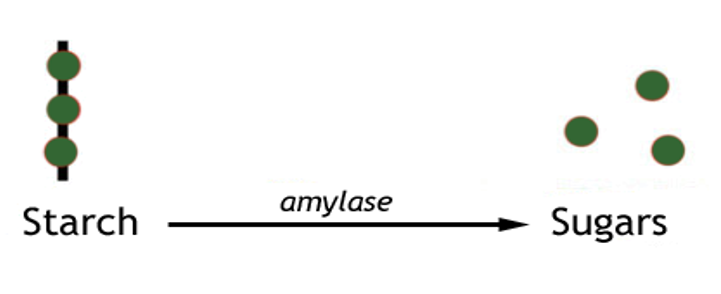
What 2 key features occur when swallowing to prevent choking
Epiglottis:
. flap of cartilage
. closes trachea (windpipe) when swallowing
. food travels down oesophagus
Peristalsis:
. involuntary muscle contractions to move food along
The oesophagus
. the tube that carries food from the throat to the stomach
—> tube 23-25cm long that connects pharynx to stomach
Role of oesophagus in digestion and how does its structure aid in this
. when food enters, the circular muscles contract behind the food to push it along
structure: wall of oesophagus has a double layer of muscle
—> circular muscle: has muscle fibres arranged in a circle
—> longitudinal muscle: has fibres arranged along the length
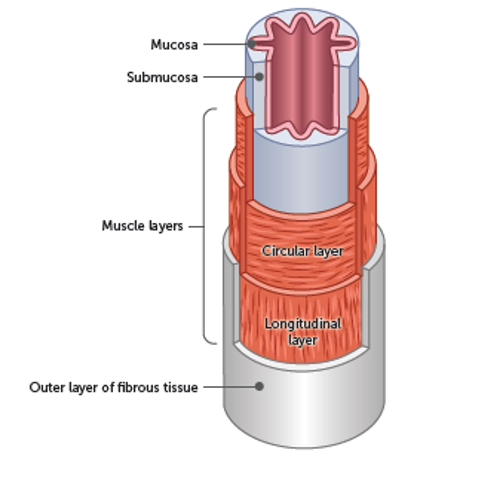
Mouth general 4 functions in digestion
. break up food
. digest starch
. kill germs
. moisten food
Stomach general 4 functions in digestion
. kill germs
. break up food
. digest proteins
. store food
Explain why stomach acid is important
. has high pH due to HCl = disinfects harmful bacteria
. activates enzymes such as pepsin to begin the breakdown of protein in food
. converts pepsinogen to pepsin
. chyme is produced from contraction of stomach muscles that mixes food with stomach acid = chemical and mechanical digestion
Lumen
. the cavity where digested food passes through + from where nutrients are absorbed
Intestines structure (structure of digestive tract)
. both intestines share general structure with whole gut + are composed of several layers
. going from inside lumen radially outwards, one passes the mucosa, submucosa, muscle layers (made up of inner circular + outer longitudinal) and serosa
—> along the whole length of the gut, there are glands which secrete mucus which lubricates the passage of food along + protects it from digestive enzymes (mucosa)
—> in small intestine, villi are vaginations (folds) of the mucosa + increase the overall SA of intestine
—> submucosa contains nerves, blood vessels and elastic fibres with collagen that stretches with increased capacity but maintains shape of intestine
—> next layer is a layer of smooth muscles (longitudinal + circular) that aids in the action of continued peristalsis along gut
—> lastly: serosa which is made up of loose connective tissue + coated in mucus to prevent friction damage from intestine rubbing against other tissue
—> holding all this in place are the mesenteries which suspend intestine in the abdominal cavity + stop it being disturbed when a person is physically active
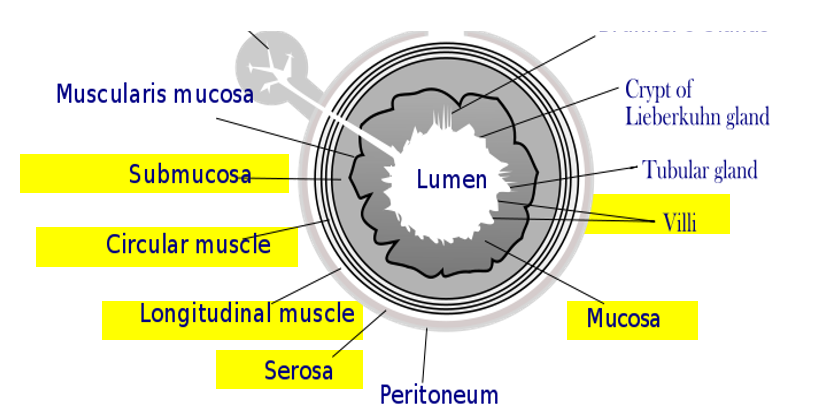
What are the accessory organs?
. structures that support the digestive process (have a role in digestive activities) but are not part of the alimentary canal itself.
. liver, gallbladder, pancreas, and salivary glands.
—> secrete substances like bile and enzymes that aid in food breakdown and nutrient absorption.
Gall bladder description
. pouch structure located near liver which stores the bile produced in liver
Bile
. a secretion of the liver, stored in the gall bladder + released into small intestine
—> contains bile salts which emulsifies fats (breaks down large molecules into small droplets) so lipases can act on a larger SA
—> contains NO enzymes
—> an alkaline fluid, when discharged into duodenum, it neutralises the acidity of the food coming from stomach, enabling lipase at its optimal pH
Bile duct
. long tube that carries bile
. connects liver + gall bladder + duodenum
Pancreatic juice and its role
. the liquid secreted by the pancreas - secretes enzymes to break down proteins, carbohydrates and fats
. contain digestive enzymes:
—> pancreatic protease = proteins to peptides
—> pancreatic amylase = starch to maltose
—> pancreatic lipases = lipids to fatty acids + glycerol
. get released along the pancreatic duct into duodenum
Small intestine description and function
. the longest part of the alimentary canal (6-7m)
. receives material from the stomach
. major organ of digestion + absorption
. has huge SA = 300m2
Function:
. chemical digestion
. absorption through lining
Small intestine structure (3 sections)
Duodenum: most chemical digestion occurs
Jejunum: effective absorption of carbohydrates + proteins
ileum: absorption of nutrients (B12, bile salts + other digestion products)
Duodenum function
. 1st section of small intestine
. receives acid food from stomach
. secretes alkaline juice
. mixes with digestive juices from pancreas, stomach, gall bladder
. secretes maltase (maltose to glucose)
. secretes endo/exo-peptidases (peptidases to amino acids)
Absorption by small intestines
. much absorption occurs directly through the wall without the need for special adaptations
. 90% of our daily fluid intake absorbed in small intestine
. has villi to increase the SA thus providing better absorption of materials
Villi
. projections from the internal lining of the small intestine
Absorption through Villi and microvilli
. finger like projections
. increase SA for absorption
. epithelial cells with many mitochondria
Name the major function of the villi and list 2 reasons why it’s suited to its function
. function: to increase the surface area of the small intestine for efficient absorption of nutrients/nutrient absorption
. suited:
—> covered in microvilli = increased absorptive SA
—> contains a lacteal which absorbs fatty acids + glycerol
—> made of blood capillaries which absorb amino acids + glucose
—> walls 1 cell thick = allows nutrients to quickly diffuse into the blood and lymphatic system
—> continual movement of villi brought about by muscular movements of the intestinal wall (constantly brings villi into contact with different parts of the intestinal contents)
Labelled diagram of a villus
Lacteal: absorbs fat soluble vitamins
Blood capillary: absorbs water + water soluble vitamins
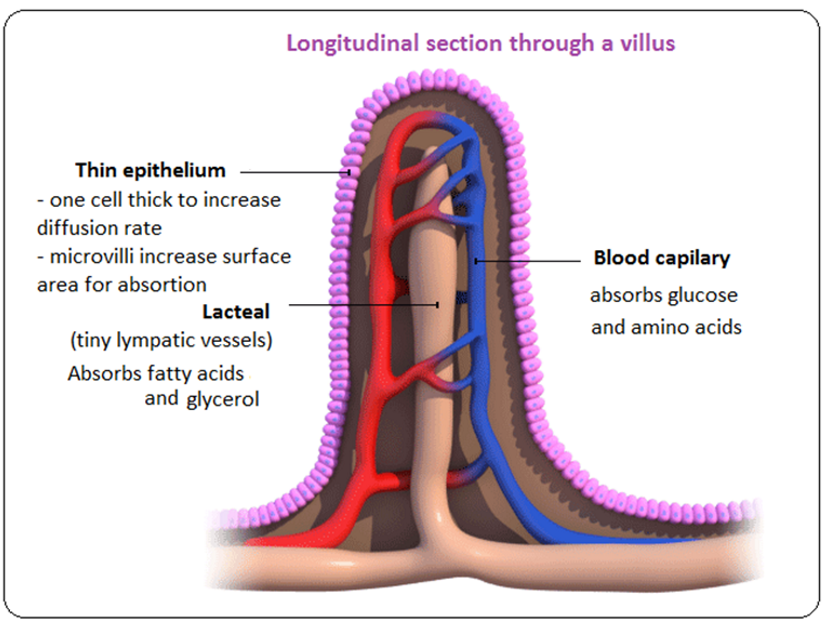
Glucose and amino acid absorption from the small intestine (NOT DONE)
Fatty acids and glycerol absorption from the small intestine (NOT DONE)
Why do fatty acids and glycerol travel by diffusion
. fatty acids + glycerol travels by diffusion, because their concentration in villi is low, as they’re immediately absorbed into lacteal
Large intestine
. the part of the intestine between the small intestine and the anus
. 1.5m long
. made up of caecum, colon, rectum and anus
. no villi + no digestive juices
. lots of mucus
. takes material 18-24hrs to travel through
. materials pass through = indigestible solids (fibres cellulose)
. water is absorbed
. vitamins K + B are secreted by good bacteria + absorbed through the walls into the blood with the water
What occurs in large intestine?
. Caecum: first part of large intestine
. Ascending colon, transverse colon, descending colon = longest part of large intestine + absorbs water, minerals and vitamins
. Rectum: final part of large intestine in which faeces are formed
. Anus: opening surrounded by the anal sphincter, a muscle that can be voluntarily controlled - solid wastes exit the body (defecation/elimination)
Describe the methods of absorption for each nutrient in the small intestine (monosaccharides, amino acids, fatty acids + glycerol, vitamins and water
Monosaccharides (glucose): absorbed by active transport enter the capillaries
Amino acids: absorbed by active transport enter the blood capillaries
Fatty acids + glycerol: absorbed by diffusion
. in the cells of the villi, fatty acids + glycerol recombine to form triglycerides, which are then coated in protein + enter the lacteals as fat droplets
Vitamins:
. Fat-soluble vitamins are absorbed with fatty acids + glycerol
. Water-soluble vitamins absorbed by diffusion through the cells
Water: absorbed by cells using osmosis
Summary of the different digestive enzymes that work in chemical digestion sheet

Constipation
. a condition in which defecation is difficult, with faeces being hard and dry
Constipation causes
. lack of roughage in the diet (cellulose/insoluble fibre - major component of plant foods) → humans have no enzymes to digest cellulose, but it’s important as it stimulates the movements of the alimentary canal
. lack of exercise
. emotional problems
. dehydration
Constipation symptoms
. as water is absorbed, faeces become drier + harder than usual
. defecation difficult + possibly painful
. gastric pain, bloating
Constipation effects
if movements of large intestine are reduced + the contents remain there for a long period of time
. compaction of faeces
Constipation treatment options
. laxatives
. increase fibre in diet
. increase hydration
. increase exercise
Diarrhoea
. the frequent passing of watery faeces
Diarrhoea causes
. irritation of the intestines
→ increases peristalsis so that their contents move through before there’s adequate absorption of water
→ irritation may be result of:
. bacteria
. virus
. parasite
. cancer
. coeliac disease
. lactose intolerance
Diarrhoea symptoms
. frequent defecation of watery faeces
. stomach pain
. vomiting
. high levels of fluid in faeces
Diarrhoea effects
if severe:
. dehydration through loss of water from intestines
. death
. bowel pain
Diarrhoea treatment options
. hydration with clear fluids + electrolytes (hydralyte)
. antibiotics (if bacterial caused)
Colorectal cancer
. cancer in the colon and rectum
. aka bowel cancer
Colorectal cancer causes
. diet: high in red + processed meat and low in fibre (fruit + vegetables)
→ being overweight/obese + physical inactivity
. age (random mutation)
. high alcohol consumption
. smoking
Colorectal cancer symptoms
. uncontrolled growth of cells in the wall of the large intestine
. stomach pain
. digestive distress
Colorectal cancer effects
Physical = changes in bowel habits (more frequent constipation/diarrhoea, weight loss, fatigue, rectal bleeding or blood in the stool
Emotional = feelings of loss, anxiety, and depression
Colorectal cancer treatment options
. surgery to remove the cancerous part of bowel, followed by chemotherapy or radiation therapy
Coeliac disease
. an autoimmune disease due to the immune system reacting to gluten
Coeliac disease causes
. inheritance
Coeliac disease symptoms
. unable to tolerate gluten protein, found in wheat, rye and barley
. vary (so difficult to diagnose)
. muscle cramps, joint pain or tingling in the legs (appear to have nothing to do with nutrition/digestion)
. asymptomatic (still in danger of malnourishment)
Coeliac disease effects
. damage to stomach lining
. if eat food containing gluten, immune system responds by damaging or destroying the villi in small intestine
→ without healthy villi, nutrients can’t be absorbed + person becomes malnourished no matter how much food they eat = serious health issues
Coeliac disease treatment options
. GF diet, however no cure
Why are people who suffer from coeliac disease likely to become malnourished? Provide an example (4 marks)
. people who suffer from coeliac disease cannot tolerate the gluten protein
. this means that when this person consumes gluten, their immune system responds by damaging or destroying the villi in the small intestine
. Healthy villi is required for the absorption of nutrients, and without this, the person can’t absorb nutrients (as reduced SA) no matter how much they eat, leading to malnutrition
. This can lead to serious health issues
Table summarising the alimentary canal organs functions in digestion and absorption and how their structure is suited to this
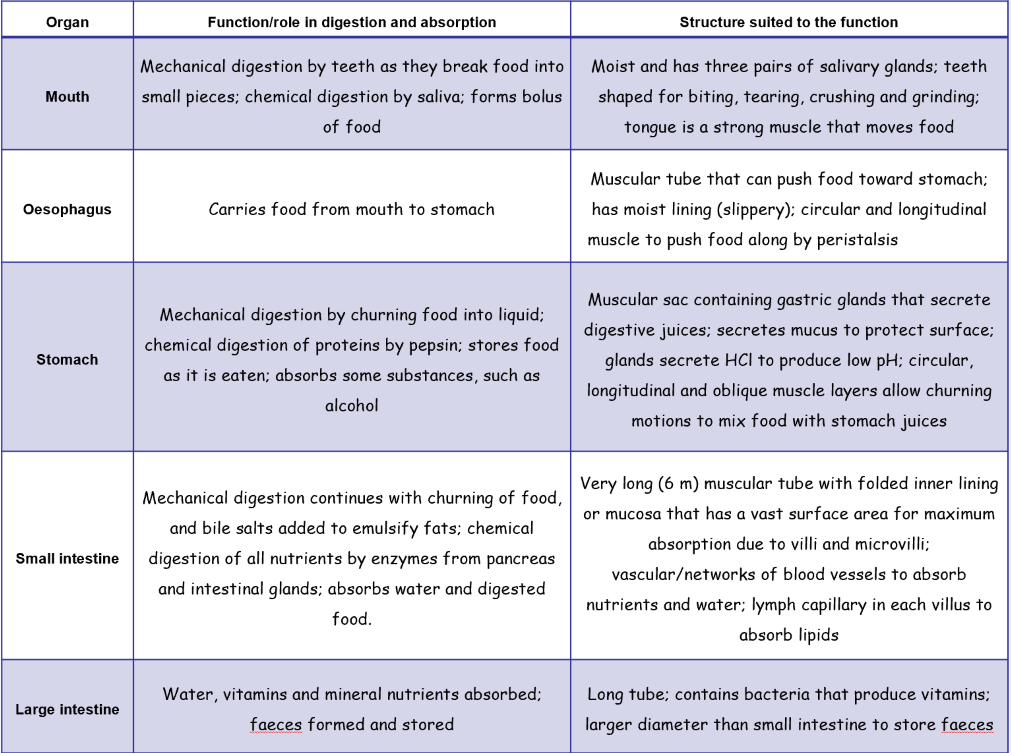
Table summarising how different digestive organs digest proteins, carbohydrates and lipids
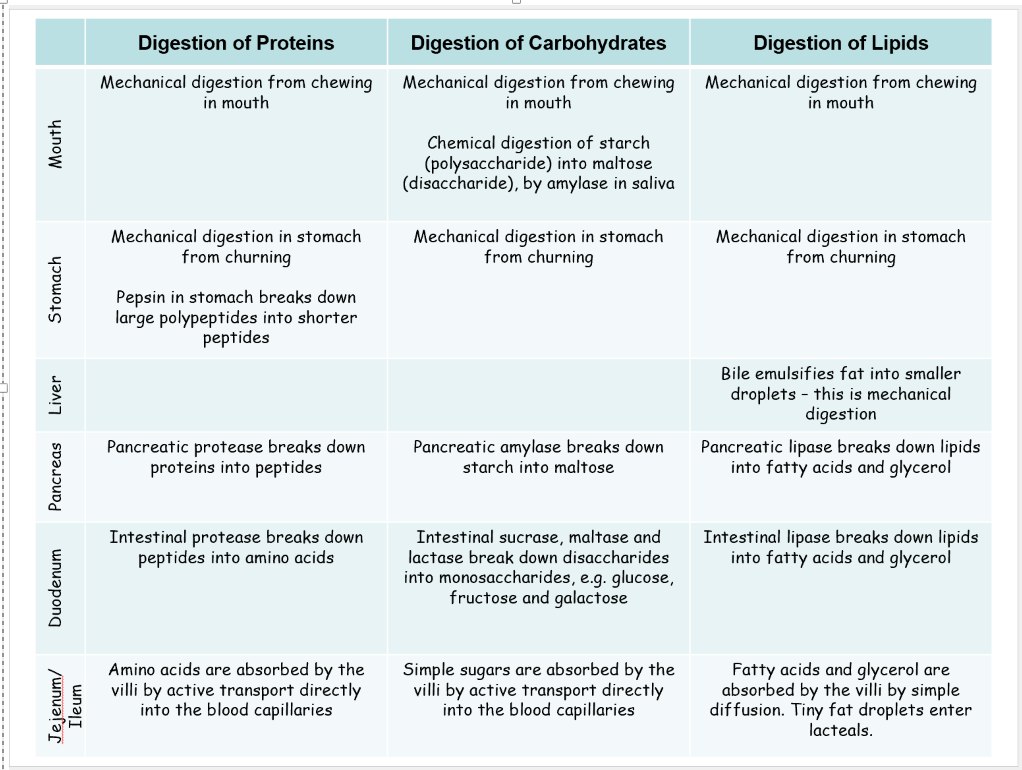
Where there are an input of enzymes to assist with chemical digestion
